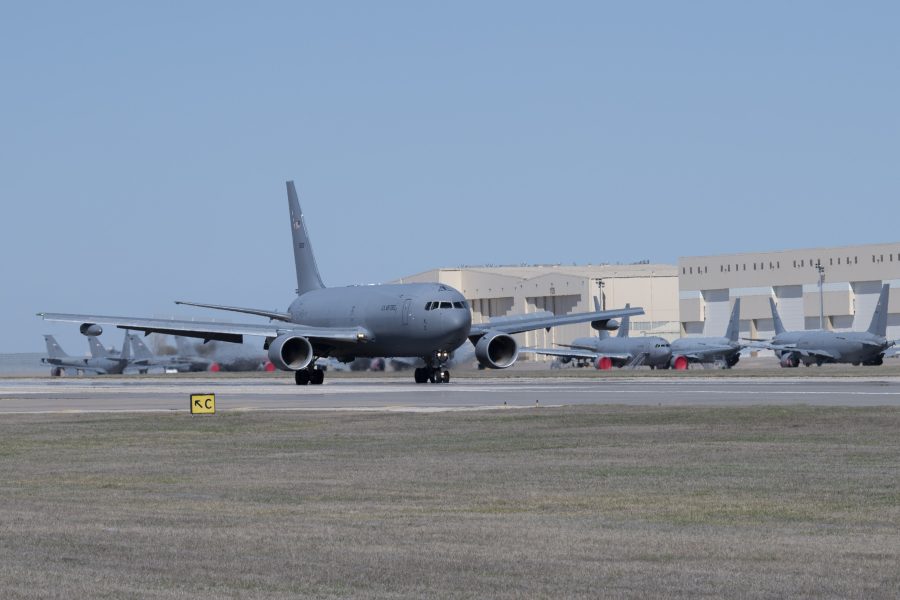Airmen started testing new Aerial Refueling Pods last month which enable the KC-46 Pegasus to refuel two naval aircraft at once, using their probe and drogue system.
McConnell is the first operational base to get the pods, which have been in development since 2019 and delayed during a lengthy FAA certification process. A team drawn from the Air Force Operational Test and Evaluation Center, 22nd Air Refueling Wing, and 931st Air Refueling Wing installed the pods March 5, according to a 22nd Air Refueling Wing statement, and the tanker has flown at least two successful missions so far, refueling two Navy F/A-18 Hornets from Naval Air Station Joint Reserve Base Fort Worth, Texas, on March 9, and two Marine AV-8B Harriers from Marine Corps Air Station Cherry Point, N.C., on March 20.
The 20-foot-long pods connect to the fuel tanks in the KC-46’s wings, and pump fuel through some 80 feet of hose at a rate up to 400 gallons per minute, depending on the receiving aircraft.
“The WARPs are an optional capability that was included in the original design of the KC-46, so there is very little difference in handling characteristics of the aircraft,” said Capt. Taylor Johnson, a KC-46 pilot. “The big challenge is making sure aircrews are properly trained and understand the additional considerations with WARPs installed on the aircraft, so they can properly execute missions.”
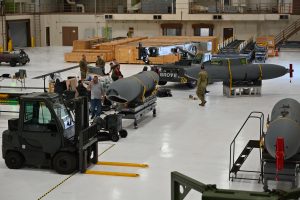
Airmen assigned the 22nd Maintenance Squadron assemble KC-46A Pegasus Wing Aerial Refueling Pods (WARPs) Jan. 24, 2024, at McConnell Air Force Base, Kansas. The WARP is an optional capability for the KC-46, it allows for the simultaneous refueling of two probe and drogue receivers, doubling fuel transfer rates. (U.S. Air Force photo by Airman 1st Class Gavin Hameed)
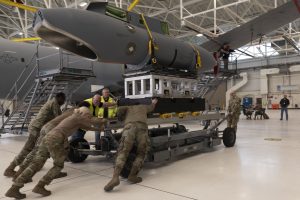
Airman from the 22 Maintenance Group push a Wing Aerial Refueling Pod (WARP) March 5, 2024, at McConnell Air Force Base, Kansas. The WARPs are an optional capability that was included in the original design of the KC-46 and certifications have been in the works since 2019. WARPs are mounted on the aircraft’s wings and allow the KC-46 to refuel two aircraft simultaneously. (U.S. Air Force photo by Airman 1st Class Gavin Hameed)
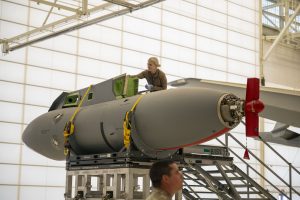
Airman Lacey Wipper, 22nd Aircraft Maintenance Squadron crew chief, applies a solution onto a KC-46A Pegasus Wing Aerial Refueling Pod (WARP) pylon March 5, 2024 at McConnell Air Force Base, Kansas. The WARPs are an optional capability that was included in the original design of the KC-46 and certifications have been in the works since 2019. WARPs are mounted on the aircraft’s wings and allow the KC-46 to refuel two aircraft simultaneously. (U.S. Air Force photo by Airman 1st Class Gavin Hameed)
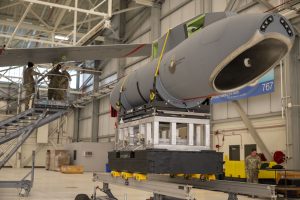
Airmen from the 22nd Maintenance Group prepare a KC-46A Pegasus for a Wing Aerial Refueling Pod (WARP) installation March 5, 2024 at McConnell Air Force Base, Kansas. The WARPs are an optional capability that was included in the original design of the KC-46 and certifications have been in the works since 2019. WARPs are mounted on the aircraft’s wings and allow the KC-46 to refuel two aircraft simultaneously. (U.S. Air Force photo by Airman 1st Class Gavin Hameed)
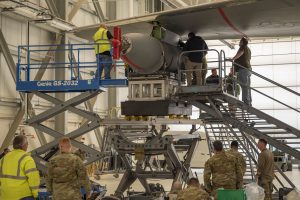
Boeing Contractors and Airman from the 22nd Maintenance Group attach a Wing Aerial Refueling Pod (WARP) onto a KC-46A Pegasus March 5, 2024 at McConnell Air Force Base, Kansas. The WARPs are an optional capability that was included in the original design of the KC-46 and certifications have been in the works since 2019. WARPs are mounted on the aircraft’s wings and allow the KC-46 to refuel two aircraft simultaneously. (U.S. Air Force photo by Airman 1st Class Gavin Hameed)
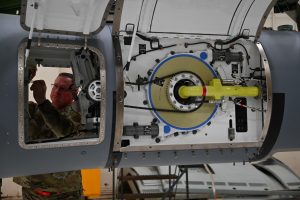
Master Sgt. Shannon Fox, 931st Maintenance Squadron hydraulic section chief, inspects the innerworkings of a KC-46A Pegasus Wing Aerial Refueling Pod (WARP) Jan. 24, 2024, at McConnell Air Force Base, Kansas. McConnell is the first KC-46 main operating base to receive the pods and start integrating them in its air refueling mission. (U.S. Air Force photo by Airman 1st Class Gavin Hameed)
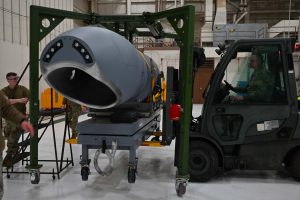
Master Sgt. Shannon Fox, 931st Maintenance Squadron hydraulic section chief, operates a forklift to raise a KC-46A Pegasus Wing Aerial Refueling Pod (WARP) Jan. 24, 2024, at McConnell Air Force Base, Kansas. The WARP is an optional capability for the KC-46, it allows for the simultaneous refueling of two probe and drogue receivers, doubling fuel transfer rates. (U.S. Air Force photo by Airman 1st Class Gavin Hameed)
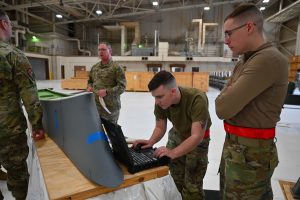
Senior Airman Ethan Tucker (left) and Airman 1st Class Austin Carella (right), both 22nd Maintenance Squadron hydraulics journaymen, look over KC-46A Pegasus Wing Aerial Refueling Pods assembly instructions Jan. 24, 2024, at McConnell Air Force Base, Kansas. McConnell is the first KC-46 main operating base to receive the pods and start integrating them in its air refueling mission. (U.S. Air Force photo by Airman 1st Class Gavin Hameed)
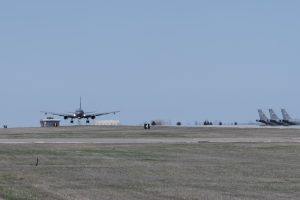
A KC-46A Pegasus, with Wing Aerial Refueling Pods (WARPs) attached, lands on the runway at McConnell Air Force Base, Kansas March 19, 2024. The KC-46 recently finished WARPs refueling with U.S, Navy F/-18 Hornets, which allows the Pegasus to simultaneously refuel two aircraft via drogue chutes. (U.S. Air Force photo by Airman 1st Class Gavin Hameed)
These tests have been a long time coming. The Air Force first successfully tested the system in 2019, and Boeing officials expressed confidence in January 2021 that FAA certification would soon follow. But the Pentagon’s director of operational test and evaluation wrote in a 2023 annual report that the pods missed a scheduled test in April 2023 because it still lacked FAA certification due to questions about wiring corrosion risk and safety tolerance in case of bird strikes. Those tests didn’t get underway until March of this year.
“We’ve been waiting for a while to get started on using WARPs,” said Airman 1st Class Cord Nakaahiki, a boom operator for the 22nd Air Refueling Wing, in a statement. But the first flight offered no surprises. “Using the new system felt just like our usual practice on simulators, which made using the real thing pretty straightforward. To be out there flying them has been exciting and rewarding.”
An Air Force Life Cycle Management Center spokesman previously told Air & Space Forces Magazine that the FAA certification will not delay initial operational testing, “as IOT&E will be conducted using one of the production article pods.”
In a statement, 22nd Maintenance Group commander Col. Robert Meadows said initial operational testing would last another two months, to “provide training for our aircrews and maintenance teams on servicing and inspecting the pods on the wings.”
